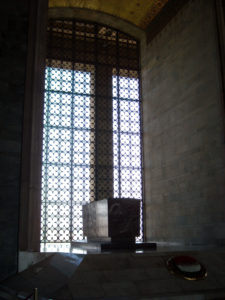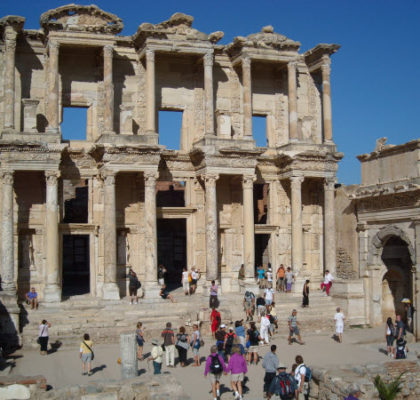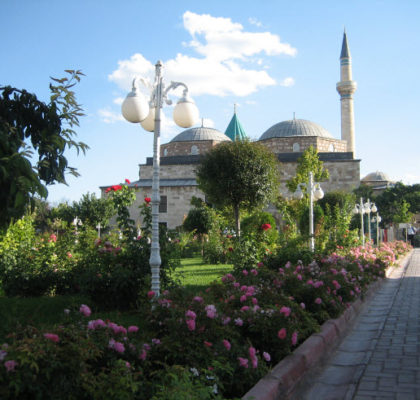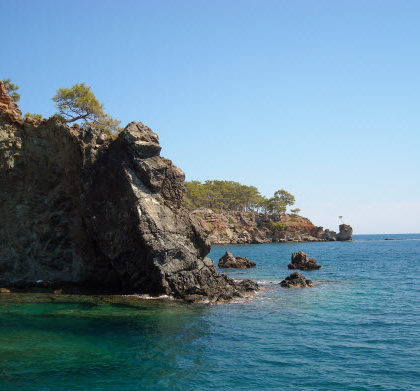- Destination Updates
- Testing the Compression Straps
- Auspicious Beginnings
- Even Old New York was Once New Amsterdam
- Accidentally in Asia
- European Capital of Culture
- Father of the Turks
- Morning in Cappadocia
- Ask an Imam
- Cleaning Up
- The Cast
- The Long Goodbye
- Our Fearless Leader
- Survivor: Istanbul Finalists
- Asia Minor Gallery
- Istanbul Notes
- Ankara Notes
- Cappadocia Notes
- Antalya Notes
- Konya Notes
- Ephesus Notes
In 1923, the capital of Turkey was moved from Istanbul to this small city best known for its wool industry (Angora, anyone?). While lacking in the old world charm of Istanbul, it is a modern capital city with wide boulevards, jumbo-sized government buildings, and Starbucks.
Museum of Anatolian Civilizations
Should you find yourself in Ankara, this museum is worth a visit. The displays show items from the various groups that have called Anatolia home from pre-history to the Hittites and Phrygians (circa 700 BC), with a touch of the Greeks and Romans added for good measure. I kind of skim the Stone Age items – having played the role of an expert in lithic technology onstage once, the fascination of stone tools is long gone – but regain interest once the art begins to show the human form in a more realistic and expressive manner (circa 2000 BC).
The core of the building if full of statuary and bas-reliefs from the Hittite and Phrygian kingdoms. This museum has the real stuff – some of the items at the archeological sites throughout the country are replicas of the items on display here. The items are well-labeled, helping to decipher the images in the well-worn stone. My favorite image – although I sadly did not take a snap of it – was of two guys on a chariot with the rearmost charioteer being eaten by a lion. He just looked like he was having a bad day.
Famous Phrygian: King Midas, of the golden touch legend. Curiously, many Phrygian kings were named Midas so it is hard to know which specific one it was supposed to be.
Another famous Phrygian story involves the Gordian knot, associated with the legends of Alexander the Great. It seems that Phrygia was king-less. The oracles – ancient Anatolian equivalents of cable news pundits – decided in a paroxysm of wisdom that the next person to enter the city with an ox cart would become their new king. Enter Gordias, peasant-like and cart-enabled, who made his way through the city to the temple where he tied his cart to a post with the renowned complicated knot. The rest is history. Gordias went on to become king. The oracles went on to invent the electoral college.
Block off a couple of hours for this museum.
Mausoleum of Ataturk

 A massive stone temple – empty except for the symbolic sarcophagus – marks the final resting place of the Father of the Turks. An honor guard made up of soldiers from all branches of the military stand vigil atop the Anatolian-style bas-reliefs that bracket the tomb. The plaza at the base of the steps to the mausoleum is encircled by museums to the man himself, venerating his life, his ideals, and his cars.
A massive stone temple – empty except for the symbolic sarcophagus – marks the final resting place of the Father of the Turks. An honor guard made up of soldiers from all branches of the military stand vigil atop the Anatolian-style bas-reliefs that bracket the tomb. The plaza at the base of the steps to the mausoleum is encircled by museums to the man himself, venerating his life, his ideals, and his cars.
As I said in an earlier blog post, the portrayal of Ataturk is not what one might call “fair and balanced.” However, as my Beloved Travel Companion pointed out, a trip to Springfield, Illinois would show a similar one-sided adulation for Abraham Lincoln. Ataturk is still an important figure in Turkey today. While his tomb and reverential museums provide some perspective on his life, it provides an even stronger insight into the cult of personality that continues to surround him.
This entry was posted in Asia Minor

